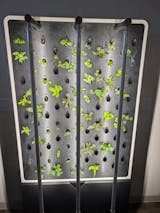Ever wondered what’s actually in the produce you’re growing in your AEVA and EVE?
We did.
As an organization dedicated to scientific research and innovation, we thought we’d go about answering that question.
In our previous blog post, we explored the importance of applying a structured approach to understanding simple questions such as “Is my food as nutritious as anything else”. Using that approach, we set out to learn how the vitamins and minerals of the produce grown in your AEVA and EVE stack up to what you normally eat.
In order to accomplish this, we applied for an ENGAGE grant through the Natural Science and Engineering Research Council of Canada (NSERC) with our partners, Seneca. NSERC is one of three government funding agencies that support scientific research in Canada. The purpose of an ENGAGE grant is to help Canadian companies generate new knowledge or apply existing knowledge to solve a company-specific problem. Awardees of these grants are selected based on four criteria. They are:
- technical merit;
- industrial relevance and potential for innovation impact;
- industrial participation and plan for technology transfer;
- and benefit to Canada.
For us, to receive this grant validates our approach.
We believe that all our organizational decisions, particularly in relation to the technology of our units, should (and is) backed by science and research.
Let’s dive into our project and show you how we’re going about answering our question mentioned above.
Project Title:
Improving Harvestable Yields and Antioxidant, Vitamin and Mineral Contents in Hydroponically Grown Basil and Mint using Indoor Vertical Gardens.
Goal:
Use different “plant recipes” (lighting cycles and watering regimes) to get the most nutritious produce possible.
Methods:
We use a combination of gas-chromatography mass spectrometry (GCMS), high-pressure liquid chromatography (HPLC), and inductively coupled plasma mass spectrometry (ICP-MS). In simple terms, these techniques take a complex sample and break it down into individual components so you can quantify how much of a given compound is found in the sample. If you are interested in learning more about these techniques, you can find more information on chromatography techniques here and mass spectrometry techniques here.
What samples are we using:
At Just Vertical, we offer over 200 different types of seeds for you to grow in your AEVA and EVE. To make fair comparisons between our products and other growing scenarios, we could only select some plants. We opted to compare our mint and basil.
We chose these varieties for two reasons.
The first is that they are some of our most popular varieties. The second is that we’ve already conducted research on these varieties in the past. Our current research was aimed at building on the nutritional data we had already gathered, and use that data to create a more thorough picture of growing strategies for basil and mint.
What parameters are we looking at:
For this project, we are primarily looking at different lighting and watering cycles for optimal growth.
What are we measuring:
Within this study we are measuring:
- Wet and dry yield: The weight of produce grown.
- Terpenes: Compounds that often give plants their aromas.
- Flavonoids: Plants products that are often associated with health benefits (Although this is contentious and no flavonoids are recognized by the FDA for these benefits).
- Antioxidants: Compounds that reduce free radicals in your body and these free radicals are associated with a number of diseases including multiple cancers and diabetes.
- Vitamins: Compounds required for proper cellular metabolism.
- Minerals: Inorganic compounds that are required for normal cellular function.
- Growth time: how long it takes to grow a plant
- Plant length: the overall length of the plant
So What?
We are in the middle of running these research projects right now to give you a growing experience that is backed by science. There are many parameters when it comes to growing your own food and we hope to share with you these results so you can be more confident in the great-tasting produce from your AEVA and EVE.

